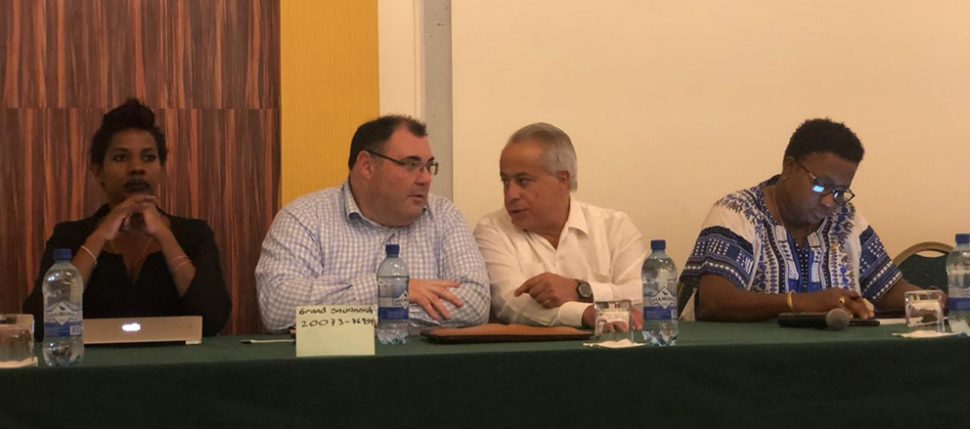With help from the European Union (EU), outdated sea and river defence legislation is being updated to take account of natural protections, such as mangroves, and to enable greater enforcement authority against encroachment.
Yesterday, the Ministry of Public Infrastructure hosted a second stakeholder consultation workshop to discuss the draft bill and another dealing with disaster risk management.
The two bills are being developed through a participatory and consultative approach, which includes a series of workshops with key stakeholders. During the period October 16th to October 25th, consultations were held in all 10 administrative regions.
Giving the feature address at the opening of the meeting, Minister within the Ministry of Public Infrastructure Annette Ferguson said that the importance of flood protection systems to Guyana’s social and economic development cannot be overemphasised as a result of the geographic characteristics and geological conditions along the country’s low-lying coastal zone. She said that it is imperative that man-made sea and river defences, drainage networks and other control structures are connected and maintained in order to prevent flooding.
Ferguson cited key limitations in the present Sea and River Defence Act. She noted that the laws to be amended are concerned primarily with man-made defences, and do not properly account for natural flood defences, such as mangroves.
Further, she said that the protection of the mangroves falls under other legislative areas (environment and forestry) but this does not serve all needs for sea and river defences, creates multi-agency difficulties and contributes to the wider problem of enforcement.
The minister also said that there is no specific enforcement authority for sea and river defences, and enforcement (against encroachment and other threats) and this has been repeatedly raised as an issue.
“The Government of Guyana has therefore proactively established provisions for the allocation of funding of sea defence construction both with national financing and donor arrangements with institutions, such as the European Union and the Caribbean Development Bank.
One important loan programme currently being implemented by the European Union Development Fund … provides disbursements of €30 million for the government over the period of 2017 through 2020,” Ferguson explained. She said that the revamping programme aims at enhancing the country’s disaster risk management and flood resilience capacity through integrated coastal zone management, including sea and river defences, drainage, mangrove reintegration and promotion of gender equality in the sea and river defence sector.
“It is recognised that improvements in the institutional, legal and policy related framework for the management of our flood protection infrastructure are necessary… We need to be pragmatic in order for us to attain such. In this context, the government, aided with financing from the European Union, developed the Sea and River Defence Sector Policy Framework in 2015 [and] this updated Sea and River Defence Policy emphasises a coordinated and integrated approach to coastal zone management considering principles of risk management,” she said.
“The Act, the current Act is indeed outdated and this is what we will be doing in order to update the Sea and River Defence Act. The Sea and River Defence legislation, laws of Guyana Chapter 64:01 and 64:02 are more than a century old,” she added.
Presentations were made by the consultants – Dr Fernando Aragon, Disaster Risk Management expert; Alana Lancaster, Legal Expert; and Chris Hedley, Legislative Drafting Expert.
The consultants noted that the objective of the programme is not to rewrite the legislation or to introduce major policy changes, but to update and refine it to meet current and future challenges.
The draft bill is divided into 12 parts. Part three is in effect a re-enactment of the core provisions of Chapter 64:02 and is designed to replicate the powers of the Board in sea/river districts. The workshop will have to decide on whether the remit of the Board should be nation-wide or whether the sea/river districts should be maintained, while the fourth part is a re-enactment of the core provisions of the Act but procedures for carrying out actions are transferred to the Board and amalgamated with the procedures covering the third part.
The fifth and sixth parts add new provisions to ensure that information is made accessible to the public as well as providing a procedure for all consultations required under the Act. The amendments also establish authorised officers, with powers to enter land, carry out inspections, order works and take enforcement actions, respectively.
Part seven creates flood protection notices as the operational procedure for authorised officers to conduct their work and to take enforcement action while the eighth part deals with offences that are substantially increased in the Act and separate penalties are specified for individuals and companies.
Part nine adds new provisions on administrative penalties as an alternative to prosecution.






